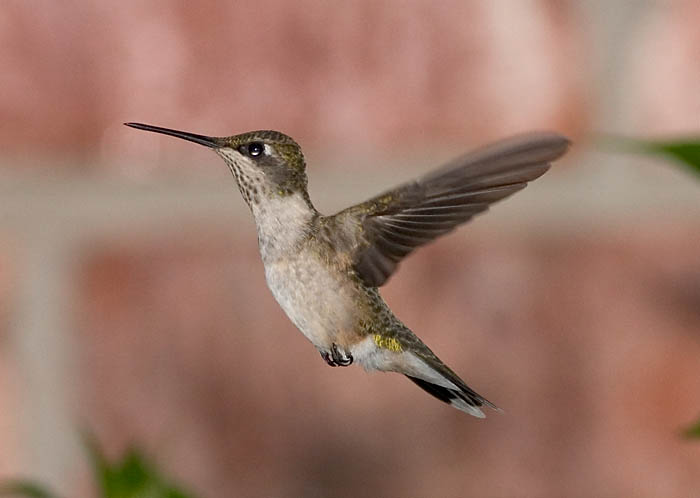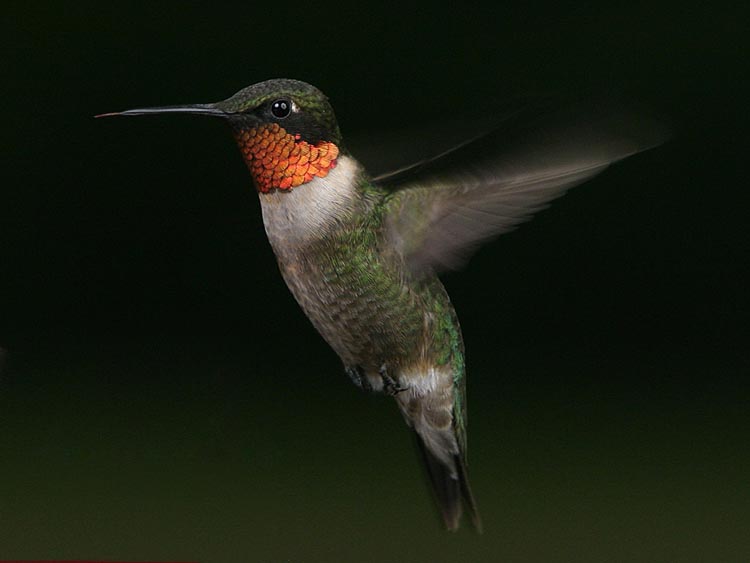
Back
How to freeze a hummingbird's wings.
This is where most beginners to either photography or
hummingbird watching trip up. I have seen quite a few usenet
and photography forum posts that begin with the following:
"I was trying to freeze a hummingbird's wings today
with my new camera. I set the shutter speed to 1/1600 and got
several shots but they came out a little dark and the wings
were still a little blurry . . ."
I have also seen comments on photographs that I have posted
that begin with:
"Wow, you must have used a really fast shutter speed .
. ."
OK, here's the secret. It isn't a high shutter speed that
freezes a hummingbird's wings, it is flash. Let me repeat:
ONLY A SHORT FLASH
DURATION CAN TRULY FREEZE A HUMMINGBIRD'S
WINGS, NOT A FAST SHUTTER!
Now that I have that out of my system,
let me explain the math. The wings on a rubythroated
hummingbird beat at approximately 50-60 beats per
second. With a wingspan that varies between birds from 3-4
inches or so, that means that the wingtips travel from front
to back about 6-8 inches, more or less. This means that the wings travel
between 300 and 500 inches per second. So a 1/1000 second
shutter speed will catch a wing movement of about 1/2 inch or
so, i.e., a complete blur. Of course, the 1/2 inch distance is not
always true because the wings don't
actually move at a constant speed. Instead, they move through
one beat, stop (or slow down greatly) and then move in the opposite direction, but you
get the idea. In order to see detail in the wings you would
need a faster shutter speed than you will find on most any
good SLR. Catching the wing near either end of a beat will
help a lot too.
There are many hotshoe flash
units out there that have flash durations as short as 1/20,000
second on their lowest power setting. There are few 35mm or
digital SLR's with a shutterspeed as fast as 1/8000 second.
Thus, using the flash to freeze the wings yields much better
results. When a hummingbird is not in direct sunlight and a
small aperture is used the flash becomes the only relevant
light source and the flash duration makes the shutter speed
meaningless. In fact, the shutter speed will be set at the
flash sync speed which, on a 35mm or digital SLR, will likely
be as low as 1/200 second.
Even a very short flash duration won't
always completely freeze a hummingbird's
wing during the middle of the flap as the following photograph
shows.

Flash duration of about 1/15,000 second.
Notice how the wingtips are still blurry!
So, how do you get detail in the whole wing?
Maybe you think of "freezing" the wings of a
hummingbird as simply being able to see the wing without
fine detail. Well, this is actually possible at a shutter
speed as slow as 1/1000 second provided you catch the
wing at the forward or rearward extension when the wing is
changing direction.

This photograph was taken with shutter set
to 1/1600 second with wings at full rearward extension.
If, when you say "freeze" the wings,
you mean show the wings as depicted in the photo above, then
it can be done with a fast shutter speed. However, even the
photo above was taken with a dedicated flash on the "high
speed sync" setting. What you will most likely find, when
you use a 1/1000 shutter speed or higher, that you will end
up with a dark photograph unless the bird was in full sun when
the photo was taken.
If you truly want frozen wings with wing
detail, then you need multiple flashes (at least three) on
their lowest setting and you need to be lucky enough to have
the flashes fire at the point where the wings are at the end
of a beat.

Four (4) hotshoe flashes, pc sync and 1/200
shutter speed at f/11 near dusk. Full bird in inset.
If you want detail like in the above
photograph, then shutter speed really is irrelevant. At ISO 100, f/16 at 1/200 second shutter speed in the shade, early
morning or late evening, everything in the
photo will be dark except what the flash units illuminate.
Therefore, if the flash duration is only 1/15,000 - 1/20,000
second, the shutter can be on 1/200 and the wings will be
frozen as above if you catch them at the right point. Of
course, for this method, you will want the bird out of direct
sunlight. If the bird is illuminated by direct sunlight, you
will get ghost images of the wings created during the time
when the shutter was open but before and after the flash
fires.
Simpler Explanation. Some have trouble with
the above paragraph and don't understand the relationships of
shutter speed and flash duration to exposure. Perhaps the
simplest way that I can explain this is to say that the way
that the camera was set up for the above exposure, had the
flash not fired, everything in the image would be essentially
black. The hummingbird was the
only thing that the flash illuminated in the image so the bird
is only shown during the time that the flash was on, or about
1/20,000 second. Even though the shutter was open for 1/200
second, nothing but what the flash illuminated shows in the
image so the shutter speed really was not a factor in the
above image.
The final point I have is a question. Do you
really want to freeze the hummingbird's wings? I have seen
comments of those who advocate freezing the wings to the
effect that a photo of a humming bird is more realistic if you
can see the wings clearly. I've never understood this. When
you are watching a hummingbird fly, the wings are a blur. Why
not let them be a blur in your photograph. When a hummingbird
is hovering in one position, the body is still enough to get
fine detail with a shutter speed of 1/500 or slower. With
fewer flashes that are diffused, you can capture much more
color than you can with non-diffused flashes. You get fewer
specular highlights (i.e., shiny areas) and the bird can
literally drip with color. To this day, I feel that the
following photograph is my best hummingbird shot, and the
wings are a nearly a complete blur.

Shot taken with two dedicated flashes in E-TTL
mode, each reflected with a white umbrella.
Even if you are satisfied with blurry wings, I
understand the desire to get a few shots with fine detail in
the wingtips. Those shots can look very impressive. I hope
this page has been helpful.

|

